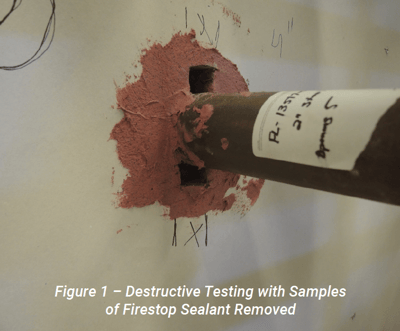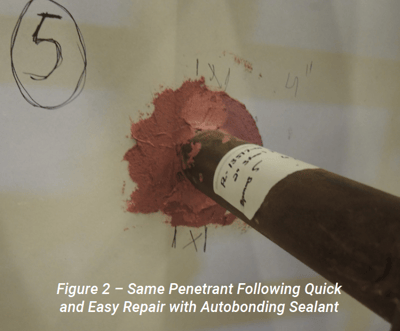Autobonding Firestop Materials Facilitate Quick Repairs
Sometimes the need to repair a firestop is unavoidable. Inadvertent jobsite
 mishaps are perhaps the most common culprit that most people would think of as a potential source of damage to installed firestops. However, there is often a need to conduct destructive sampling tests of firestop materials to ensure compliance with the appropriate tested system. The thickness of the firestop material in this small specimen, which was obtained from destructive testing, is compared to a benchmark value to confirm the firestop has been properly installed. Both accidents and deliberate destructive testing can create a firestop system that needs to be repaired. Do we have to start from scratch and replace the entire existing firestop or is there an easier solution?
mishaps are perhaps the most common culprit that most people would think of as a potential source of damage to installed firestops. However, there is often a need to conduct destructive sampling tests of firestop materials to ensure compliance with the appropriate tested system. The thickness of the firestop material in this small specimen, which was obtained from destructive testing, is compared to a benchmark value to confirm the firestop has been properly installed. Both accidents and deliberate destructive testing can create a firestop system that needs to be repaired. Do we have to start from scratch and replace the entire existing firestop or is there an easier solution?
The best approach to repairing a damaged firestop is to select a material for the initial install that is autobonding. The firestop industry  has come to define an autobonding material as one that can be repaired or patched with a new batch of identical material. That is to say, the newly installed sealant, spray, etc. will properly adhere to the existing material that has already been allowed to cure. Selecting an autobonding product leads to expeditious repairs since only the impacted area needs to be replaced as compared to the removal of the entire firestop for a material that does not support autobonding. The table below shows some of the STI product line that is formulated to autobond. Please consult the individual product data sheets or reach out to our Engineering Services for additional information.
has come to define an autobonding material as one that can be repaired or patched with a new batch of identical material. That is to say, the newly installed sealant, spray, etc. will properly adhere to the existing material that has already been allowed to cure. Selecting an autobonding product leads to expeditious repairs since only the impacted area needs to be replaced as compared to the removal of the entire firestop for a material that does not support autobonding. The table below shows some of the STI product line that is formulated to autobond. Please consult the individual product data sheets or reach out to our Engineering Services for additional information.
STI Firestop Products Capable of Autobonding
- SpecSeal® SSS Intumescent Sealant
- SpecSeal® LCI Intumescent Sealant
- SpecSeal® LC Endothermic Firestop Sealant
- WF300 Intumescent Firestop Caulk
- SpecSeal® SIL Silicone Firestop Sealant
- SpecSeal® ES Elastomeric Sealant
- SpecSeal® AS200 Elastomeric Spray
- SpecSeal® Fast Tack® Firestop Spray
- SpecSeal® Safing Spray
- SpecSeal® Smoke ‘N’ Sound Smoke and Acoustical Sealant
- SpecSeal® Smoke ‘N’ Sound Spray
- SpecSeal® CS105 Cable Spray






